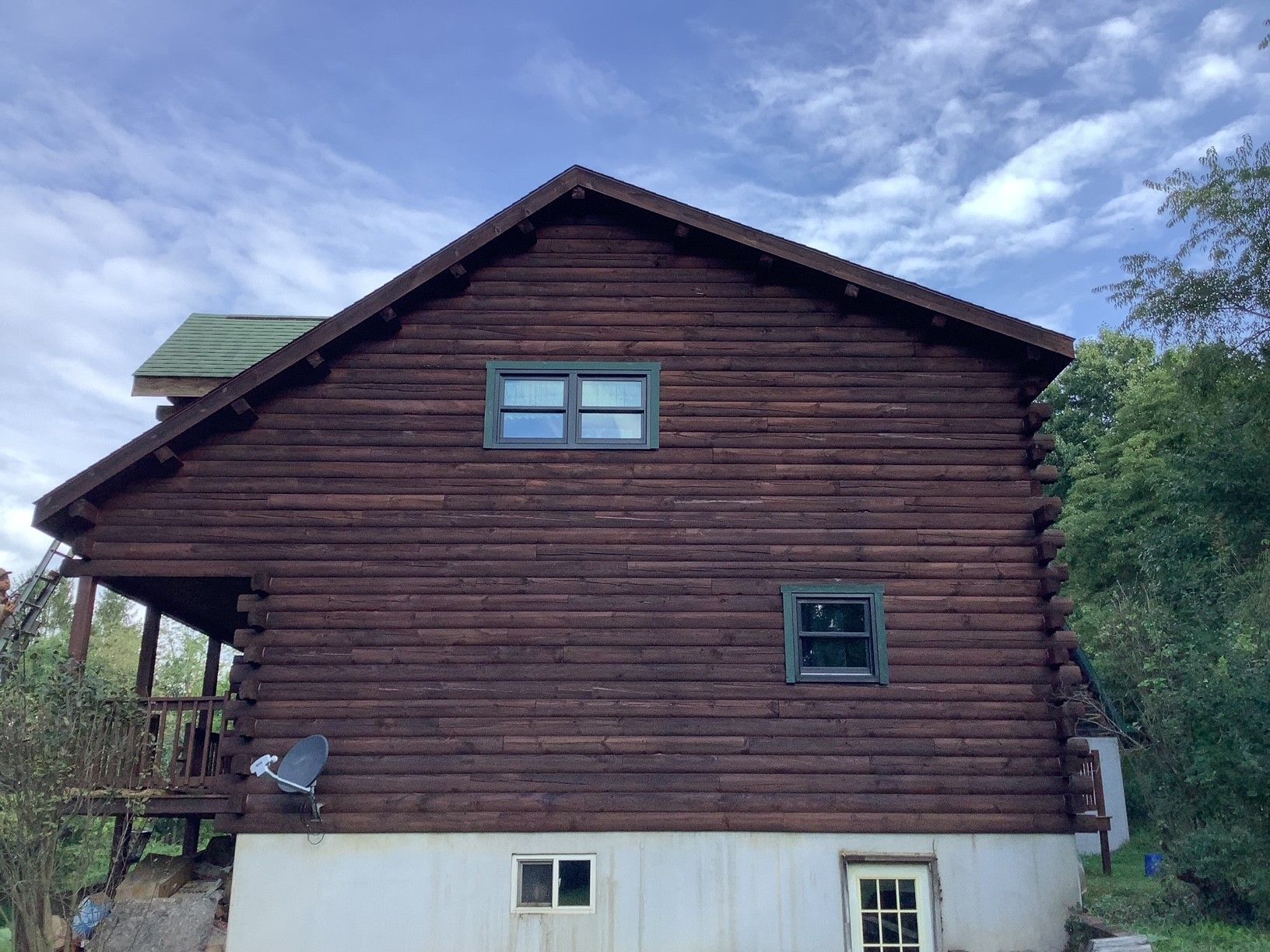LOG CABIN STAINING SERVICE
Log Staining
Log staining, within the realm of Log & Timber Solutions, refers to the process of applying a colored solution to wood surfaces to enhance their appearance and provide protection. This method involves the absorption of pigments or dyes into the wood's pores, thereby altering its color while still allowing the natural grain and texture to remain visible. Log Cabin Staining serves both aesthetic and practical purposes, offering a range of finishes from transparent to opaque, and providing protection against environmental factors such as UV radiation, moisture, and insects.

Why is Log Cabin Staining Needed?
Log staining plays a crucial role in the maintenance and longevity of log and timber structures. These types of wood constructions are highly susceptible to deterioration caused by exposure to the elements, including sunlight, moisture, and temperature fluctuations. Properly applied stains not only enhance the natural beauty of wood but also provide a protective barrier against moisture infiltration, UV damage, and fungal decay. Additionally, staining allows cabin owners to customize the appearance of their log structures to suit their aesthetic preferences while ensuring long-term durability and structural integrity.
We never recommend any product that is opaque. These products should be blasted off and a new protection system applied. Opaque products do not allow proper inspection of your log condition and it is not uncommon for log rot to grow significantly before a homeowner can see it. These opaque products generally do not breathe very well. Over 95% of the log rot we see is on logs that have an opaque product applied to them.
Log Cabin Staining
How Does Log Staining Work?
Log Cabin Staining involves a multifaceted process that relies on intricate chemical reactions and application methods to achieve desired outcomes. Understanding the mechanics of staining is vital for effectively treating log and timber surfaces. Here's a breakdown of the key elements involved:
Chemical Composition of Log Stains: Stains consist of pigments, binders, solvents, and additives. Pigments provide color and opacity, binders hold pigment particles together and adhere them to the wood surface, solvents dissolve binders and pigments to create a homogeneous mixture, and additives enhance performance and durability.
Process of Log Staining: Staining begins with surface preparation, including cleaning, sanding, and conditioning to ensure proper adhesion and penetration of the stain. The stain is then applied using various methods such as brushing, spraying, or wiping, depending on the desired finish. Wood fibers absorb the stain, allowing pigments and binders to penetrate and provide color and protection. Finally, the solvent evaporates, and the stain dries to form a protective film on the wood surface.
Factors Influencing Staining Effectiveness:
Several factors affect staining effectiveness, including the wood species' porosity and grain patterns, the quality of surface preparation, climate conditions such as temperature and humidity, and the chosen application method.
Benefits of Log Cabin Staining
Log staining is not just about adding color; it offers a multitude of benefits that make it an invaluable treatment for log and timber surfaces. Here's an in-depth exploration of the advantages associated with staining:
Preservation of Wood: Stains penetrate the wood fibers, forming a protective barrier against moisture. This inhibits the growth of mold, mildew, and rot, preserving the wood's structural integrity. Additionally, certain stains contain additives that deter insects like termites and wood-boring beetles, while minimizing swelling and shrinking to maintain dimensional stability.
Enhancement of Aesthetic Appeal: Stains come in a diverse range of colors, allowing for customization to match individual preferences and architectural styles. Transparent and semi-transparent stains accentuate the natural grain patterns and textures of the wood, enhancing its visual appeal. Staining also provides even and consistent coloration across the surface, masking imperfections and creating a cohesive look that elevates the wood's beauty.
Protection Against Weathering and UV Damage: Many log stains contain UV inhibitors that shield the wood from harmful ultraviolet rays, preventing fading, discoloration, and degradation caused by prolonged exposure to sunlight. Additionally, stains form a durable barrier that protects against the damaging effects of rain, snow, wind, and temperature fluctuations, thereby preventing deterioration, cracking, and warping over time.
Longevity of the Finish: Stains penetrate deep into the wood, offering long-lasting protection against wear, abrasion, and surface damage. Stained surfaces require less frequent maintenance compared to untreated wood, with routine cleaning and occasional recoating being typically sufficient to keep the finish looking fresh and vibrant for years to come. Despite the initial investment in staining being higher than untreated wood, the long-term savings in maintenance, repair, and replacement costs make it a cost-effective choice in the long run.
Staining provides a comprehensive solution for enhancing and maintaining the beauty and durability of log and timber surfaces. Its benefits extend far beyond mere coloration, making it an essential treatment for preserving, enhancing, and protecting wood for generations to come.
Log & Timber Solutions
Our Log Cabin Staining Solutions
As you've discovered, staining offers numerous benefits for preserving, enhancing, and protecting log and timber surfaces. If you're ready to transform your wood structures and ensure their longevity, don't wait any longer. Visit Log & Timber Solutions' website today to learn more about our comprehensive staining services and products.
Our log cabin staining experts are dedicated to providing tailored solutions to meet your specific needs, whether you're looking to preserve the natural beauty of your wood or add a touch of color and character to your outdoor spaces. With our high-quality stains and professional guidance, you can achieve stunning results that will stand the test of time.
Don't miss out on the opportunity to enhance the beauty and durability of your log and timber surfaces. Take action now and explore the wide range of staining solutions available at Log and Timber Solutions.
Call (888) 909-5647 Today!


Frequently Asked Questions about Log Cabin Staining
Which Stain last the longest?
 Button
ButtonEvery manufacturer will tell you 3-5 years you will typically need to do something somewhere on your cabin, it is normal to have 1-2 sides of your log cabin seeing significantly more UV exposure, wind, and rain. The extent of that work will epend on the type of protection system you have. Some stain systems require you do the entire house each interval whether it needs it or not to keep a consistent look, while others allow for an “as-needed, where-needed” approach. Maintenance costs should be a significant factor when making a decision on what protection system to utilize.
What is better Oil or Water?
 Button
ButtonWell, this is a trick question. Each type of protection system has it’s advantages and disadvantages, and each person may have different requirements for “better” specific scenario and expectations should be discussed with your estimator when onsite. With that said, almost all newbuild log cabins that we see are using traditional waterbased stain systems like capture/Cascade or Permachinks Ultra-2/7 and Lifeline Advanced. They are regarded as the highest level of protection with the easiest/least maintenance long
term currently.
